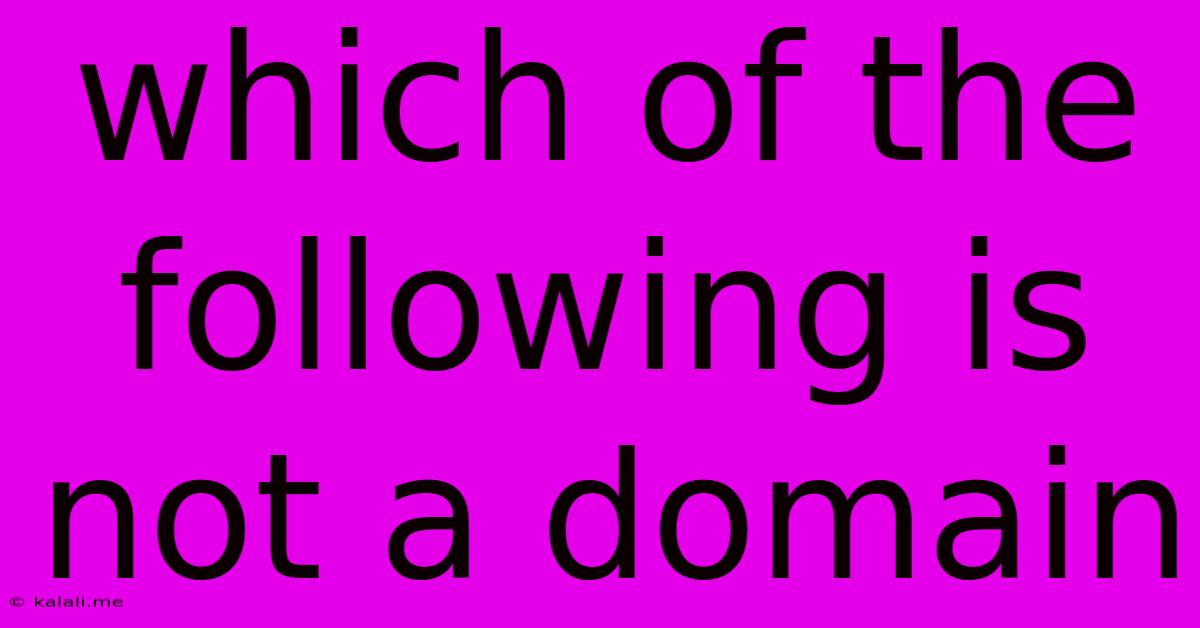Which Of The Following Is Not A Domain
Kalali
Jun 12, 2025 · 3 min read

Table of Contents
Which of the following is not a domain? Understanding Domain Names and Related Concepts
This article aims to clarify the concept of a domain name and differentiate it from other internet-related terms. Understanding what constitutes a domain is crucial for anyone navigating the digital world, whether you're a website owner, a casual internet user, or someone interested in web development. We'll explore what a domain is, and importantly, what it is not.
What is a Domain Name?
A domain name is essentially the address of a website. It's the human-readable part of a URL (Uniform Resource Locator) that you type into your browser to access a website. For example, in the URL www.example.com, "example.com" is the domain name. It's a unique identifier that translates into a numerical IP address that computers use to locate the website's server. Think of it as the street address for a website on the internet. Domain names are hierarchical, often containing multiple parts separated by dots (periods).
What is NOT a Domain Name?
While the concept of a domain name seems straightforward, several internet-related terms are frequently confused with it. Let's explore some common examples:
1. IP Address: The Numerical Address
An IP address (Internet Protocol address) is a numerical label assigned to each device connected to a network that uses the Internet Protocol for communication. It's the actual address that computers use to communicate with each other. Unlike domain names which are human-readable, IP addresses are a series of numbers (e.g., 192.168.1.1). Therefore, an IP address is not a domain name. Domain names are essentially user-friendly representations of these IP addresses.
2. URL: The Complete Web Address
A URL (Uniform Resource Locator) is the complete address used to locate a resource on the internet. It includes the protocol (e.g., http:// or https://), the domain name, and often a path to a specific file or page on the website. For example, https://www.example.com/about-us is a URL. The domain name is part of the URL, but the URL itself is not a domain name. The URL is a broader concept that includes the domain.
3. Subdomain: Part of a Larger Domain
A subdomain is a subordinate domain that is part of a larger domain. For example, blog.example.com is a subdomain of example.com. While it's related to the domain, it's not the main domain itself. A subdomain functions under the parent domain, so it's not a separate domain.
4. Web Hosting: The Service, Not the Address
Web hosting is the service that provides the physical space on a server to store your website's files and make them accessible on the internet. It's the infrastructure that supports the website, not the address itself. You need a domain name to access a website hosted on a server, but the hosting service itself is not a domain name.
5. File Paths: Location Within a Website
File paths specify the location of a particular file or folder within a website. They are part of the URL after the domain name. For example, /images/logo.png is a file path. File paths are integral to website structure but are clearly distinct from a domain name.
In Conclusion:
While several terms relate to the internet and website access, only a specific name registered with a domain registrar constitutes a domain name. Understanding the difference between domain names, IP addresses, URLs, subdomains, web hosting, and file paths is critical to navigating the online world effectively. Remember, a domain name is your website’s unique address, easily remembered by users and essential for online presence.
Latest Posts
Latest Posts
-
What Is The Value Of X 3 5 7 9
Jun 13, 2025
-
Which Of The Following Is True Of Alternating Current
Jun 13, 2025
-
Wheat Is A Monocot Or Dicot
Jun 13, 2025
-
What Are The Factors Of 360
Jun 13, 2025
-
Find The Lcm Of 15 And 18
Jun 13, 2025
Related Post
Thank you for visiting our website which covers about Which Of The Following Is Not A Domain . We hope the information provided has been useful to you. Feel free to contact us if you have any questions or need further assistance. See you next time and don't miss to bookmark.